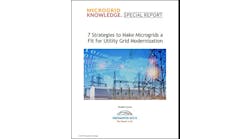Demand for microgrids is growing. But how do microgrids make money when they are part of the U.S. grid?
By Number1411/Shutterstock.com
Much depends on standards set by regulators, policymakers and grid operators, which are likely to vary depending on where the microgrid is located.
Utility regulation is set at the state level. So microgrid operators may find themselves navigating 50 different sets of rules. Moreover, the buying and selling of power into wholesale markets relies on rules set by different grid operators. Ten independent system operators (ISO) and regional transmission operators (RTO) serve two-thirds of US electricity consumers in what is known as the organized markets.
Microgrids are likely to thrive in markets where electricity prices are high, large condensed load exists (such as college campuses or denser urban business districts), and where they can take advantage of their efficiencies to offer a cost-effective product.
So simple geography will affect a microgrid’s return on investment.
Several other factors also play into microgrid economics, as DNV KEMA points out in its August 2013 paper, Microgrids for Fun and Profit. Fuel prices, financing costs, timing of construction, equipment costs, and government incentives, all influence a microgrid’s value.
Revenue sources
The most obvious revenue source for a microgrid is its host. Depending on how the microgrid ownership is structured, the microgrid may charge retail energy rates from the energy users it serves. Microgrids can further improve their economics through sophisticated wholesale transactions and by maximizing power and thermal production. They are a capital intensive asset, so will likely require high load factors and utilization to generate a competitive rate of return for investors.
Operators describe engaging in various hedging strategies and market transactions to reduce their costs, manage operating risks or earn revenue. For example, a microgrid is likely to manage use of its onsite energy and storage to avoid peak energy costs. Microgrids also can earn revenue by selling power back to the grid when it makes sense economically. In addition, they can reduce costs and earn revenue by participating in demand response programs or wholesale capacity and ancillary services markets. They may sell into carbon credit markets or provide utilities with renewable energy or energy efficiency credits to meet state portfolio standards.
Microgrid operators express confidence that they can successfully compete in these various markets – if they are offered fair compensation for services.
“If we can improve the regulatory environment to properly value many of the benefits for these assets, that will create pull in the marketplace for more investment. The perceived risk will be diminished if revenue streams are clarified and market access rules are more consistent,” says Robert Thornton, president and CEO, International District Energy Association.
Unrecognized benefits
But there is an even bigger economic hurdle for microgrid operators. Microgrids offer benefits that go unrecognized. How do microgrid advocates convince policymakers to assign value to these benefits? For example, power outages cost the US economy $18 to $33 billion annually between 2003 and 2012, according to the US Department of Energy. Microgrids help reduce these costs by keeping the power flowing to their host customers.
Then there is the issue of avoided costs. A microgrid built by a private developer in a strategic location might avert the need for a utility to build or reinforce transmission and distribution infrastructure. Private investors pay for the microgrid, yet utility operators and ratepayers benefit. How should the microgrid be compensated for reducing grid congestion or strengthening the grid overall?
This is one area that will be subject to much more discussion, especially since the current utility business model rewards investment in assets, but does not adequately incentivize efficiency, reliability, and optimization of system integration. In short, the regulatory rules of the road must evolve quickly for emergent microgrid technologies to compete with traditional utility investment strategies. Regulatory guidance is critical.
There is another, larger risk faced by microgrids, one not so easily managed and likely to play a key role in determining the growth trajectory of the microgrid industry. That risk is the microgrid’s relationship with its local utility, and it is central to today’s policy discussions about microgrids. We will discuss the utility/microgrid relationship in the next article of our Think Microgrid series.
Come back next week for the fourth article in this series, or immediately download the full report, free of charge: Think Microgrid: A Discussion Guide for Policymakers, Regulators and End Users, courtesy of the report’s underwriters: the International District Energy Association, Schneider Electric and Microgrid Knowledge.







